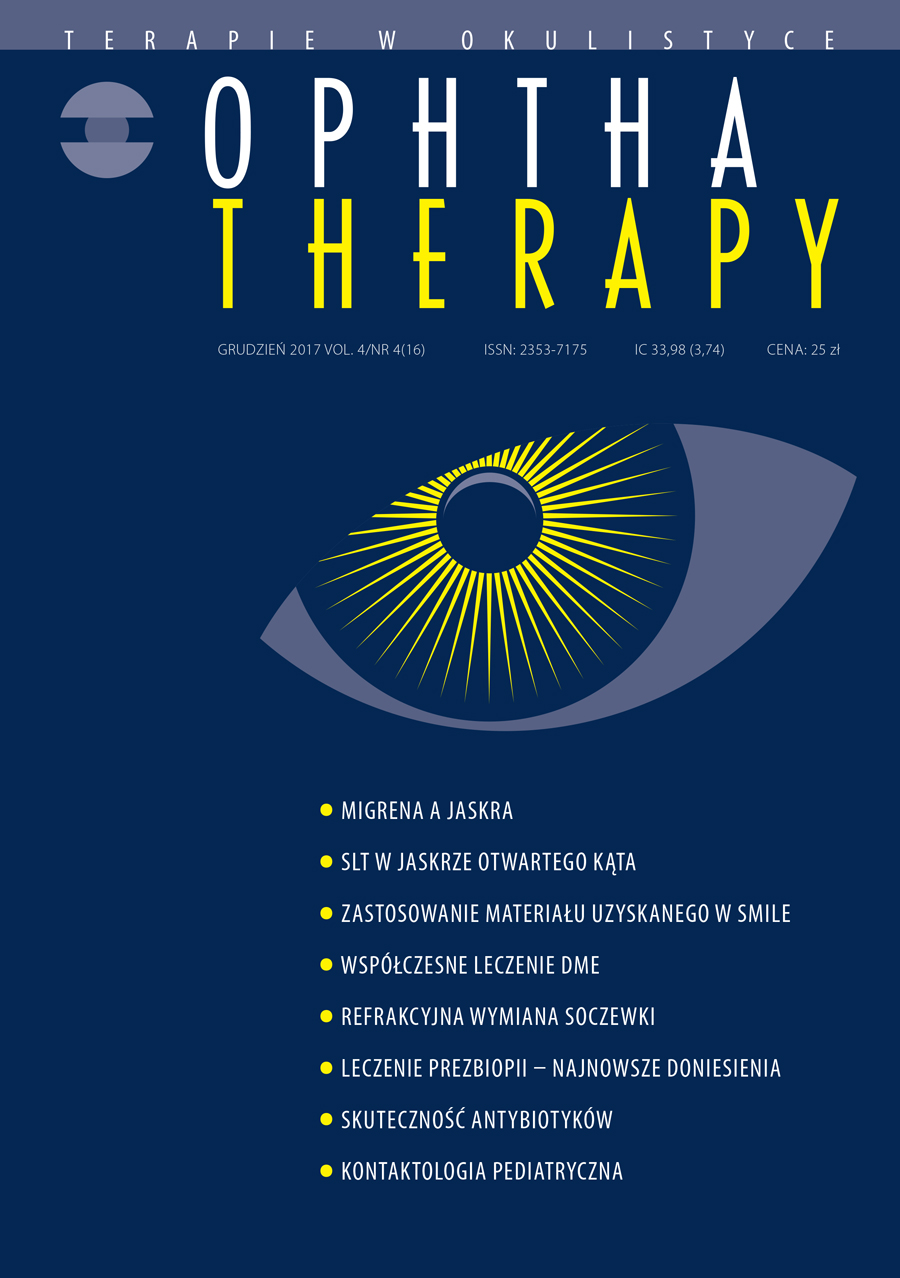Refractive lens exchange with a trifocal lens Alcon AcrySof® IQ PanOptix® – a controversy or a standard
Main Article Content
Abstract
Refractive lens exchange is still relatively new and slightly controversial method of correcting the refractive errors. The surgery consists of extracting the patient’s own lens using phacoemulsification technique in non-existent or irrelevant for sight opacifications in lens and implant of artificial intraocular lens. With modern surgery technique improvements and higher multifocal intraocular lens availability allowing the wide spectrum of acute vision, this technique becomes an attractive alternative to laser vision correction, especially in societies with higher presbyopia rates. The study included 7 patients (11 eyes) operated solely for refractive errors and/or presbyopia with Alcon AcrySof® IQ PanOptix® implant. In examination we evaluated refractive errors, both corrected and uncorrected visual acuity for distance and near, and improved quality of life and patient satisfaction after surgery. Refractive lens exchange is an effective alternative to laser eye surgery, at the same time being free from laser limitations such as high myopia or hyperopia, cornea thickness or dry eye syndrome.
Downloads
Article Details

This work is licensed under a Creative Commons Attribution-NonCommercial-NoDerivatives 4.0 International License.
Copyright: © Medical Education sp. z o.o. License allowing third parties to copy and redistribute the material in any medium or format and to remix, transform, and build upon the material, provided the original work is properly cited and states its license.
Address reprint requests to: Medical Education, Marcin Kuźma (marcin.kuzma@mededu.pl)
References
2. Apple DJ, Sims J. Harold Ridley and the invention of the intraocular lens. Surv Ophthalmol. 1996; 40(4): 279-92.
3. Hoffman RS, Fine IH, Packer M. Refractive lens exchange with a multifocal intraocular lens. Curr Opin Ophthalmol. 2003; 14(1): 24-30.
4. Dick HB, Gross S, Tehrani M et al. Refractive lens exchange with an array multifocal intraocular lens. J Refract Surg. 2002; 18(5): 509-18.
5. Haigis W. Challenges and approaches in modern biometry and IOL calculation. Saudi J Ophthalmol. 2012; 26(1): 7-12.
6. Holladay JT, Prager TC, Chandler TY et al. A three-part system for refining intraocular lens power calculations. J Cataract Refract Surg. 1988; 14: 17-24.
7. Barrett GD. An improved universal theoretical formula for intraocular lens power prediction. J Cataract Refract Surg. 1993; 19(6): 713-20.
8. Grabska-Liberek I, Derlacka D, Skowyra A. Nowoczesne metody leczenia zaćmy. Borgis – Postępy Nauk Medycznych. 2013; 12: 880-3.
9. Levinson BA, Rapuano CJ, Cohen EJ et al. Referrals to the Wills Eye Institute Cornea Service after laser in situ keratomileusis: reasons for patient dissatisfaction. J Cataract Refract Surg. 2008; 34: 32-9.
10. Pinero D, Alio JL. PesbyMax: Presbyopia correction by multifocal LASIK. Cat Ref Surg Today. 2009; 1: 38-9.
11. Vargas-Fragoso V, Alió JL. Corneal compensation of presbyopia: PresbyLASIK: an updated review. Eye and Vision. 2017, 4: 11.
12. Kohnen T. First implantation of a diffractive quadrafocal (trifocal) intraocular lens. J Cataract Refract Surg. 2015; 41: 2330-2.
13. Marek J, Ogar A. Trójogniskowa soczewka wewnątrzgałkowa PanOptix®. Pierwszy rok doświadczeń. OphthaTherapy. 2016; 4(12): 287-92.
14. PanOptixTM Diffractive Optical Design. Alcon internal technical report: TDOC-0018723. Effective date: 19 Dec 2014.
15. Bronicki D, Miller M, Dyda W et al. Pseudosoczewkowość po operacji zaćmy nie musi ograniczać. Soczewka trójogniskowa jako rozwiązanie problemu starczowzroczności. OphthaTherapy. 2015; 4(8): 286-91.
16. Average of American OSHA, Canadian OSHA and American Optometric Association Recommendations for Computer Monitor Distances.
17. Charness N, Dijkstra K, Jastrzembski T et al. Monitor Viewing Distance for Younger and Older Workers. Human Factors and Ergonomics Society Annual Meeting Proceedings. 2008; 52(19): 1614-7.
18. National Eye Institute Visual Functioning Questionnaire – 25 (VFQ-25) version 2000. https://nei.nih.gov/sites/default/files/nei-pdfs/vfq_sa.pdf.
19. Farbowitz MA, Zabriskie NA, Crandall AS et al. Visual complaints associated with the AcrySof acrylic intraocular lens. J Cataract Refract Surg. 2000; 26(9): 1339-45.
20. Vasavada AR, Raj SM, Shah A et al. Comparison of posterior capsule opacification with hydrophobic acrylic and hydrophilic acrylic intraocular lenses. Cataract Refract Surg. 2011; 37(6): 1050-9.
21. Nishi O, Nishi K, Sakanishi K. Inhibition of migrating lens epithelial cells at the capsular bend created by the rectangular optic edge of a posterior chamber intraocular lens. Ophthalmic Surg Lasers. 1998; 29(7): 587-94.
22. Gundersen KG, Potvin R. Trifocal intraocular lenses: a comparison of the visual performance and quality of vision provided by two different lens designs. Clin Ophthalmol. 2017; 11: 1081-7.
23. Lawless M, Hodge C, Reich J et al. Visual and refractive outcomes following implantation of a new trifocal intraocular lens. Eye Vis. 2017; 4: 10.
24. García-Pérez JL, Gros-Otero J, Sánchez-Ramos C et al. Short term visual outcomes of a new trifocal intraocular lens. BMC Ophthalmol. 2017; 17: 72.
25. Monaco G, Gari M, Di Censo F et al. Visual performance after bilateral implantation of 2 new presbyopia-correcting intraocular lenses: Trifocal versus extended range of vision. J Cataract Refract Surg. 2017; 43: 737-47.

